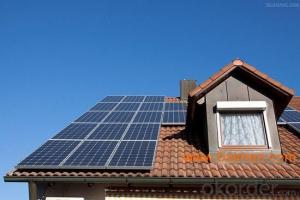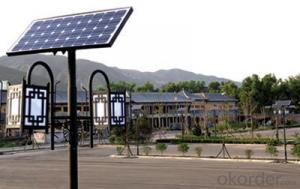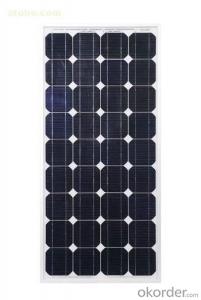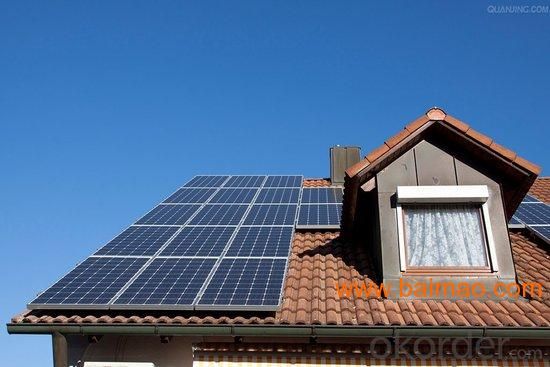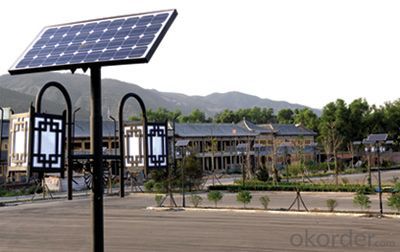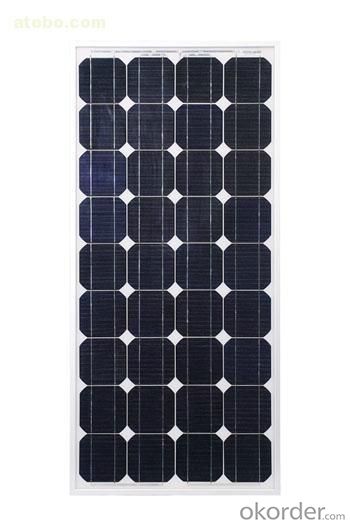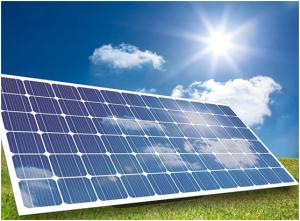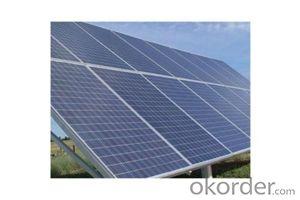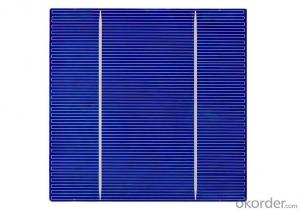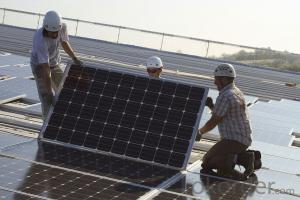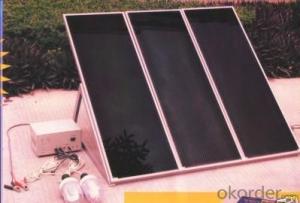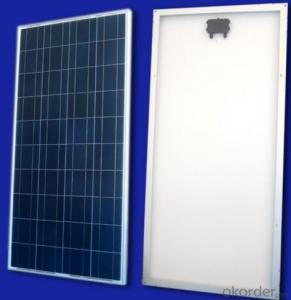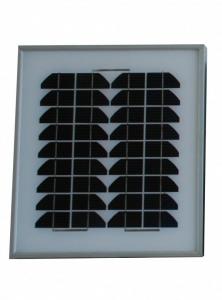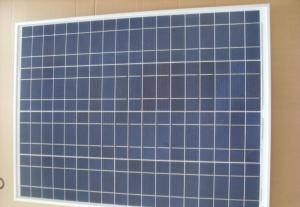Fafco Pool Solar Panels 275w - 230w-320w High Efficiency Best Price
- Loading Port:
- China main port
- Payment Terms:
- TT OR LC
- Min Order Qty:
- 1000 watt
- Supply Capability:
- 100000 watt/month
OKorder Service Pledge
OKorder Financial Service
You Might Also Like
Structure
A PV module is a packaged, connected assembly of typically 6×10 solar cells. Solar PV panels constitute the solar array of a photovoltaic system that generates and supplies solar electricity in commercial and residential applications. Each module is rated by its DC output power under standard test conditions, and typically ranges from 100 to 320 watts. The efficiency of a module determines the area of a module given the same rated output – an 8% efficient 230 watt module will have twice the area of a 16% efficient 230 watt module. There are a few solar panels available that are exceeding 19% efficiency. A single solar module can produce only a limited amount of power; most installations contain multiple modules. A photovoltaic system typically includes a panel or an array of solar modules, an inverter, and sometimes a battery and/or solar tracker and interconnection wiring.
Feature
1. 10 years limited product warranty
2. 15 years at 90% of the minimal rated power output
3. 25 years at 80% of the minimal rated power output
Picture
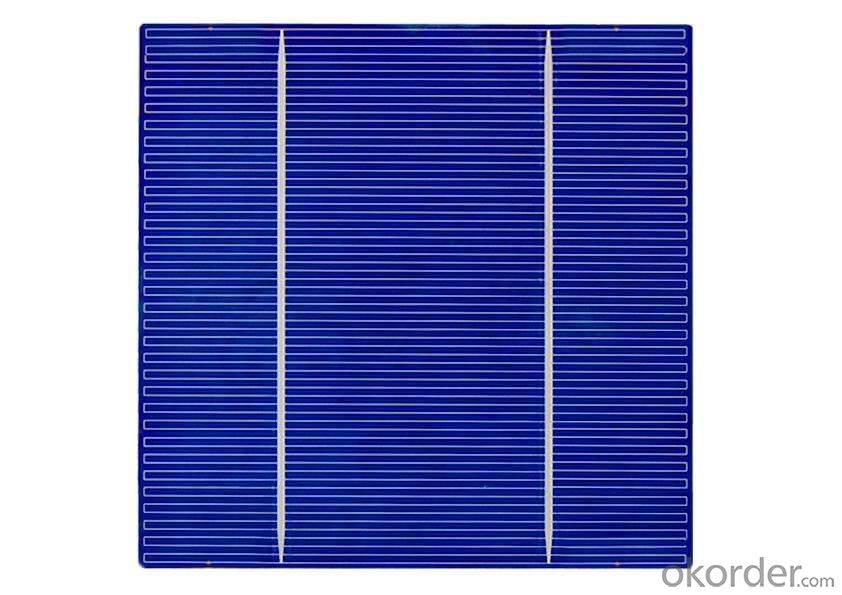
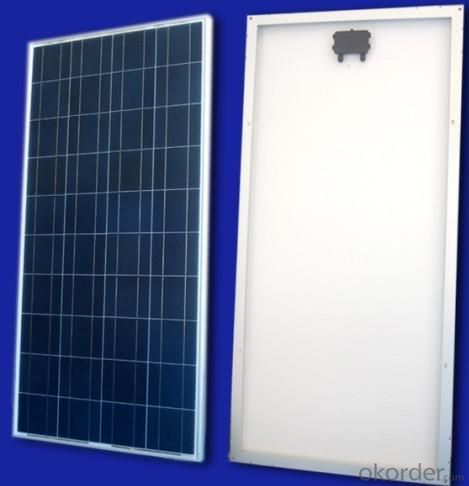
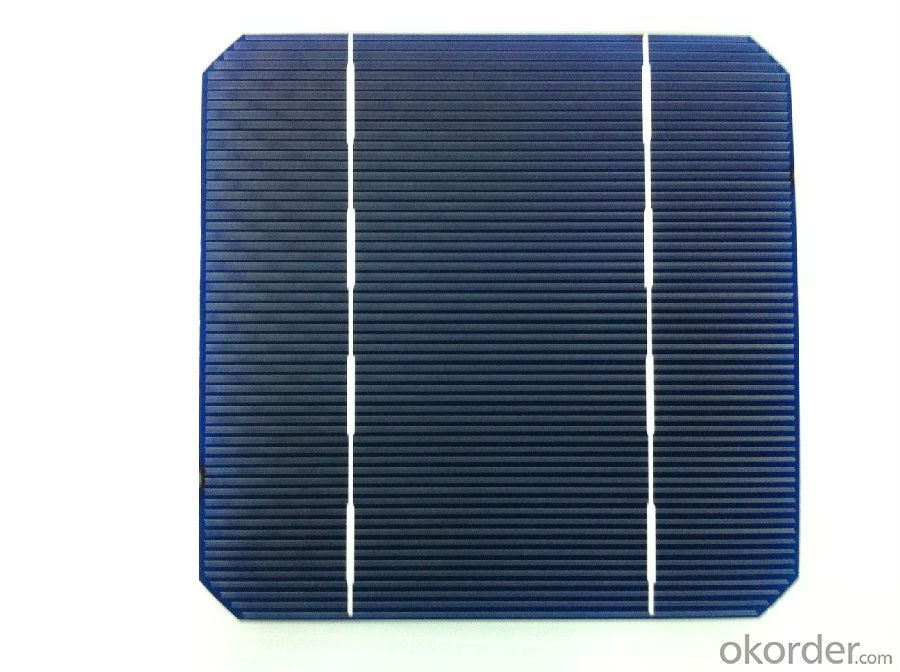
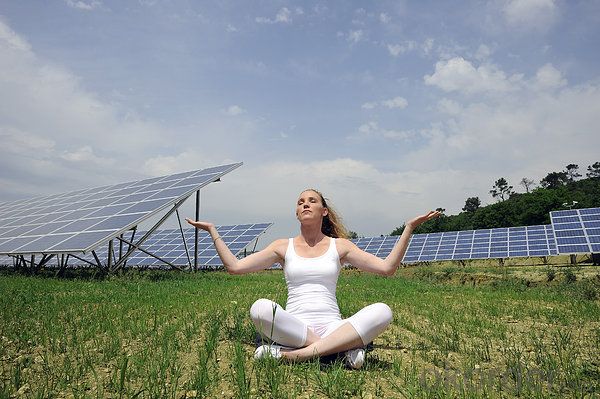
Specification
ITEM NO.: | Poly 156*156 cell ,60pcs . Power range from 230Wp-260Wp | |||||||||
Maximum Power(W) | 230 | 235 | 240 | 245 | 250 | 255 | 260 | |||
Optimum Power Voltage(Vmp) | 29.4 | 29.5 | 29.7 | 30.1 | 30.3 | 30.5 | 30.7 | |||
Optimum Operatige Current(Imp) | 7.83 | 7.97 | 8.08 | 8.14 | 8.25 | 8.37 | 8.48 | |||
Open Circuit Voltage(Voc) | 36.7 | 36.8 | 36.9 | 37.1 | 37.3 | 37.5 | 37.7 | |||
Short Circuit Current(Isc) | 8.52 | 8.59 | 8.62 | 8.65 | 8.69 | 8.73 | 8.78 | |||
Solar Cell: | 156*156 Poly | |||||||||
Number of Cell(pcs) | 6*10 | |||||||||
Brand Name of Solar Cells | JA Cell, Bluesun Cell | |||||||||
Size of Module(mm) | 1650*992*40/45/50 | |||||||||
Cable & Connector Type | Pass the TUV Certificate | |||||||||
Frame(Material Corners,etc.) | Aluminium-alloy | |||||||||
Back sheet | TPT | |||||||||
Weight Per Piece(KG) | 19.5KG | |||||||||
FF (%) | 70-76% | |||||||||
Junction Box Type | Pass the TUV Certificate | |||||||||
Tolerance Wattage(e.g.+/-5%) | ±3%, or 0-3% | |||||||||
Front Glass Thickness(mm) | 3.2 | |||||||||
Temperature Coefficients of Isc(%) | +0.04 | |||||||||
Temperature Coefficients of Voc(%) | -0.38 | |||||||||
Temperature Coefficients of Pm(%) | -0.47 | |||||||||
Temperature Coefficients of Im(%) | +0.04 | |||||||||
Temperature Coefficients of Vm(%) | -0.38 | |||||||||
Temperature Range | -40°C to +85°C | |||||||||
Surface Maximum Load Capacity | 5400Pa | |||||||||
Allowable Hail Load | 23m/s ,7.53g | |||||||||
Bypass Diode Rating(A) | 12 | |||||||||
Warranty | 90% of 10 years, 80% of 25 years. | |||||||||
Standard Test Conditions | AM1.5 1000W/ 25 +/-2°C | |||||||||
Packing | carton or pallet | |||||||||
1*20' | 14 Pallets / 316pcs | |||||||||
1*40'STD | 25 Pallets / 700pcs | |||||||||
FAQ:
Are you a trading company or manufacturer? | Manufacturer with factory |
What kinds of filter do you produce? | It covers for air filter,oil filter,fuel filter for car and truck |
Is Customized filter available? | Yes,please offer your required specifications and drawing |
Do you Accept OEM service? | YES! |
what’s your delivery terms? | FOB (2)CFR (3)CIF |
What's your Delivery Time? | 1)generally the samples will be sent immediately by the air express in 3-5 days if the goods are in stock |
2)Normally within 30 days,please confirm with us before order! | |
What's the Payment Terms? | Usually,30% as deposit,70% before shipment by T/T |
Western Union acceptable for small amount. | |
L/C acceptable for large amount. | |
Scrow ,Paybal,Alipay are also ok | |
How you pack products? | Normally,plastic bag inside and carton outside .We'll do according to customers' requirement |
What's your available port of Shipment? | Normally, Tianjin Other ports available but you should afford extra charges. |
Trade and Market | Main Market Western European 20% |
- Q: Can solar panels be used for powering a manufacturing facility?
- Yes, solar panels can be used to power a manufacturing facility. Solar energy can be converted into electricity, which can then be used to power various processes and equipment in a manufacturing facility. This can help reduce reliance on traditional energy sources and promote sustainability. However, the feasibility and capacity of solar power for a manufacturing facility would depend on factors such as the facility's energy requirements, available space for solar panel installation, and local sunlight conditions.
- Q: So, I've seen cheap solar panel kits for sale from Harbor Freight, and regardless of whether or not I were to buy a set from them or someone else, I was wondering what the process of implementing a small-scale solar system into your household electrical system would be.I've read articles that started out too in-depth or were speaking of systems on a much larger scale.Can it be as easy as buying the panels and inverter, and plugging it into a socket, or is there more to it?Some of the articles I was reading had mentioned having to contract with your electrical supplier, having to have an electrician tie it all in in some special/ necessary way, using a battery pack (would this be necessary for a tied-in system?), or using the system to only power single items, like a water heater, or plugging items into a connected battery-pack, all of which I'm not sure is necessary or needed for what my goals/ means are/ would be.
- You can't directly connect solar panel into household electrical system,you need to convert DC power to AC power more over it will cost more amount...
- Q: Does anyone know how I would go about hooking up the air conditioners in my house to solar panels? I would want just the air conditioners to be powered by solar energy. How could I hook it up where the panels can absorb energy from the sun during the day, and save and store the energy so I can run the air conditioners at night? I really feel that in the long run, this would save a lot of money with the energy bill. It's the use of the air conditioners that drive up the bill. Is this idea feasible? Is it also possible to have some sort of hybrid system where I can switch from solar to my regular local energy source when I want to?
- There's no need to connect only the A/C to solar, nor is there a need to use batteries. Both of those problems are solved with grid-tied solar. The solar electricity system works alongside your regular, and the A/C just plugs in normally. You never need to worry about switching. During the day, if the A/C is drawing power, the solar goes into that, reducing your draw from the electric company. If the solar generates more than the A/C needs, the meter is driven backwards. At night, the meter runs forward again. For example, the meter may read 5000 in the morning. By evening, maybe it reads 4975. At night, it creeps back up to 5005. When the meter reader comes, you would be billed for only 5 kWh. That's the general idea. Also, consider whether you can insulate your home more, and whether you might want to change out your air conditioners for new, DC inverter mini-split units. Those can use a fraction of the electricity per BTU of regular air conditioners.
- Q: I have made a 5v dc 52watt solar panel and I going to be trying to charger 4 2v dc 55ah batteries. I get about 6 hours of sun on my panel. Spec below, is that a big enough panel to charge the batteries???I have 30 3x6 solar cells wired together Cell Specifications: (Watts): .75 Wp (Amps): 3.5 Imax (Volts): 0.5 V max which is where I got my 5g 52watt max (if math is wrong plz tell me) The Battery type: 2Volt 55.0ah NB Sealed Lead Acid Battery. I am using a mppt solar charger.
- OK your math on the solar panel looks correct, but you are missing some critical information. What is the load on your batteries and for how long is this load being applied. Calculate the amp-hour load to see if your solar panel can recharge your batteries with the amount of sun light available. A safe engineering standard is to have twice as much capability as required. If you have a 200 amp load for 7.5 minutes, this would be a 25 amp-hour discharge and will take your solar panel over 7 hours to recharge your batteries. Your solar panel can easily charge the batteries up to full capacity with out any load on the batteries, if the batteries are 50% discharged, this will take about 32 hours. CAUTION! I am assuming that you are hooking the batteries up in a parallel connection, that will give you over 200 amps of current. You should charge each battery up to full charge before you connect them together, if they are not at the same exact voltage when you connect them together, they will self adjust so that each battery is at the same voltage level, at 55 amps this could be a very large spark. Each cell, there are six (6) cells in a 2 volt battery, should be at 2.7 to 2.2 volts DC per cell at full charge. Make sure your battery has a voltage 3.02 to 3.26 volts open circuit or no load. This should be full charge if your batteries do not have this voltage level, say one battery is at 0 volts DC, it could have a dead or shorted cell. DO NOT use this battery until you can get it to hold a 3.02 to 3.26 volt DC level.
- Q: Can solar panels be used to power an air conditioning system?
- Yes, solar panels can be used to power an air conditioning system. Solar energy can be converted into electricity, which can then be used to power various appliances including air conditioning units. By harnessing the power of the sun, solar panels can provide a sustainable and cost-effective solution for cooling homes and buildings.
- Q: How do I choose the right size of solar panels for my home?
- To choose the right size of solar panels for your home, you should consider factors such as your average electricity consumption, available roof space, and budget. Start by analyzing your energy usage over the past year to determine your average daily kilowatt-hour (kWh) consumption. Next, calculate the solar panel system size needed by dividing your average daily consumption by the average daily sunlight hours in your area. Additionally, assess your roof's orientation, shading, and structural capacity to determine the maximum number of panels it can accommodate. Finally, take your budget into account and consult with a professional solar installer to help you determine the appropriate size and type of solar panels that best meet your energy needs.
- Q: Can solar panels work in cloudy weather?
- Yes, solar panels can still generate electricity even in cloudy weather. While direct sunlight produces the most optimal conditions for solar panel efficiency, they can still function and generate power in cloudy weather due to their ability to convert diffused sunlight into electricity. However, the electricity output may be lower compared to sunny days.
- Q: Can solar panels be installed in areas prone to hurricanes or tornadoes?
- Yes, solar panels can be installed in areas prone to hurricanes or tornadoes. However, it is important to design and install the solar panel system with the specific weather conditions in mind. This includes using appropriate mounting systems, ensuring proper anchoring and reinforcement of the panels, and using high-quality materials that can withstand strong winds. Additionally, regular maintenance and inspections should be conducted to ensure the panels remain in optimal condition.
- Q: The colder a solar panel gets the more efficient it seems to be. As the panel warms, it loses some efficiency. Why is this so? Please explain in a way you would expect a high school kid to understand it, as I am a high-schooler and i have to explain this to other high-schoolers.
- Absolutely temperature matters. So what do higher temperatures do to solar photovoltaic panels? As temperatures rise, the efficiency of solar panels decreases. Heat causes electrical resistance to the flow of electrons. On days where the temperature is more than 75 degrees, the electrical resistance makes the voltage fall thereby producing less kilowatts per hour. Your roof is much hotter than temperatures on the ground. That’s why solar panels are not mounted flat to a roof. There’s usually a few inches of spaces between the panels and roof so air flow can easily pass through and cool the panels down. There are some photovoltaic panels that are designed specifically to operate in hotter temperatures. These panels have a higher temperature coefficient. This is especially important in high heat climates like Arizona or New Mexico, but probably wouldn’t make too much of a difference in New England (except maybe this year). If someone lives in one of these areas, they should speak to a solar installer to make sure they are using they right equipment for their region. Please note: Solar thermal panels used to heat water can withstand high temperatures without any degradation. In fact, hotter temperatures would actually be better for these types of modules.
- Q: With no moving parts, no fuel piping and so on...
- ITS TO DO WITH THE PRODUCTION PROCESS
Send your message to us
Fafco Pool Solar Panels 275w - 230w-320w High Efficiency Best Price
- Loading Port:
- China main port
- Payment Terms:
- TT OR LC
- Min Order Qty:
- 1000 watt
- Supply Capability:
- 100000 watt/month
OKorder Service Pledge
OKorder Financial Service
Similar products
Hot products
Hot Searches
Related keywords
